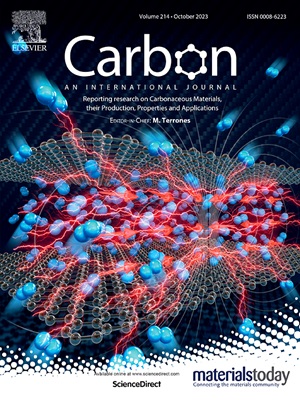Effects of chemical structure of mesogenic components on the mechanical properties of mesophase pitch-based carbon fiber
IF 10.5
2区 材料科学
Q1 CHEMISTRY, PHYSICAL
引用次数: 0
Abstract
Carbon fiber (CF) is a high-performance material with a wide range of industrial applications due to its light weight and excellent mechanical properties. Mesophase pitch (MP)-based CF (MPCF) is a type of CF with superior mechanical properties. Precursor MP is complex, with multiple components, and recent studies have revealed its lyotropic liquid crystal properties. The solvent components in the lyotropic liquid crystal are important for facilitating the technically challenging melt spinning of MP, and the concentration of mesogenic components influences the mechanical properties of the resulting MPCF. However, the effects of different mesogenic components on the physicochemical characteristics of MP and the mechanical properties of MPCF remain unclear. This study was performed to investigate how the characteristics of mesogenic components in MP affect the mechanical properties of MPCF. Precursor MPs were prepared using mesogenic components extracted from three different naphthalene-based, coal tar-based, and petroleum-based parent MPs, combined with a specific solvent component at the same concentration. The structure of the mesogenic components influenced MP formation with the solvent component. Mesogenic components containing naphthenic ring structures exhibited high affinity and stacking properties with the solvent component. Mechanical evaluations revealed that the tensile strength and Young's modulus of the resulting graphitized fibers varied depending on the properties of the mesogenic components. Notably, mesogenic components containing naphthenic ring structures led to the formation of larger crystallites in the graphitized fibers, enhancing their tensile strength (maximum tensile strength of 4.0 GPa) and Young's modulus (maximum Young's modulus of 618 GPa).
介相组分化学结构对中间相沥青基碳纤维力学性能的影响
碳纤维(CF)是一种高性能材料,由于其重量轻,机械性能优异,具有广泛的工业应用。中间相沥青基CF (MPCF)是一种具有优异力学性能的CF。前驱体MP是一种复杂的多组分化合物,近年来的研究揭示了其溶致液晶特性。溶致液晶中的溶剂组分对于实现熔融纺丝具有重要的技术意义,而介生组分的浓度会影响所得到的熔融纺丝的力学性能。然而,不同的介晶组分对高分子材料理化特性和力学性能的影响尚不清楚。本研究的目的是研究MP中介生成分的特性如何影响MPCF的力学性能。采用从萘基、煤焦油基和石油基三种不同的母体MPs中提取的介生组分,结合相同浓度的特定溶剂组分制备前驱体MPs。介生组分的结构影响了溶剂组分与聚丙烯酸甲酯的形成。含环烷环结构的介系组分与溶剂组分具有较高的亲和性和叠加性。力学评价表明,石墨化纤维的拉伸强度和杨氏模量随介晶组分的性质而变化。值得注意的是,含有环烷基环结构的中生组分导致石墨化纤维中形成更大的晶体,提高了其抗拉强度(最大抗拉强度为4.0 GPa)和杨氏模量(最大杨氏模量为618 GPa)。
本文章由计算机程序翻译,如有差异,请以英文原文为准。
求助全文
约1分钟内获得全文
求助全文
来源期刊

Carbon
工程技术-材料科学:综合
CiteScore
20.80
自引率
7.30%
发文量
0
审稿时长
23 days
期刊介绍:
The journal Carbon is an international multidisciplinary forum for communicating scientific advances in the field of carbon materials. It reports new findings related to the formation, structure, properties, behaviors, and technological applications of carbons. Carbons are a broad class of ordered or disordered solid phases composed primarily of elemental carbon, including but not limited to carbon black, carbon fibers and filaments, carbon nanotubes, diamond and diamond-like carbon, fullerenes, glassy carbon, graphite, graphene, graphene-oxide, porous carbons, pyrolytic carbon, and other sp2 and non-sp2 hybridized carbon systems. Carbon is the companion title to the open access journal Carbon Trends. Relevant application areas for carbon materials include biology and medicine, catalysis, electronic, optoelectronic, spintronic, high-frequency, and photonic devices, energy storage and conversion systems, environmental applications and water treatment, smart materials and systems, and structural and thermal applications.
 求助内容:
求助内容: 应助结果提醒方式:
应助结果提醒方式:


